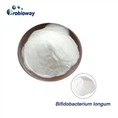Lactobacillus acidophilus can reproduce by binary fission, a common method of reproduction for prokaryotes such as bacteria.
The process works as follows:
1. DNA replication
The single circular chromosome of Lactobacillus acidophilus is replicated to produce two identical copies of the genetic material, which ensures that both daughter cells have the same genetic information.
2. Cell elongation
The bacterial cell grows and elongates, leaving enough room for the two sets of DNA to move to opposite ends of the cell.
3. Septum formation
The fission septum begins to form in the middle of the cell, separating the two sets of DNA.
4. Cell division
The septum completely divides the mother cell into two genetically identical daughter cells.
5. Independent growth
Each daughter cell grows independently, and they can grow and reproduce under favorable conditions.
Conditions that help reproduction:
Nutrient availability: L Acidophilus feeds on carbohydrates, converting them into lactic acid.
Optimum temperature: Usually around 37°C (98.6°F), similar to human body temperature.
Adaptable to low-oxygen environments: As a facultative anaerobe, it can grow in both oxygen-rich and low-oxygen environments but prefers low oxygen environments.
Acidic pH: The bacterium prefers acidic environments (pH values of approximately 4.5-6.5).
By multiplying in this way, L Acidophilus can quickly colonize its environment, effectively maintaining a balanced microbiota and inhibiting the growth of harmful pathogens.





